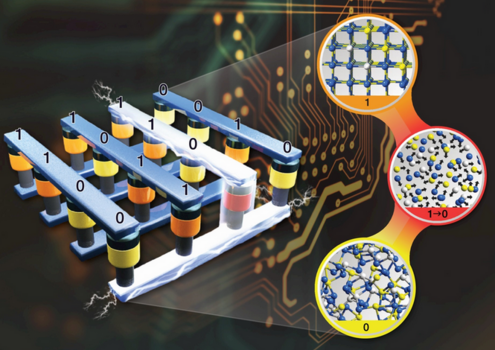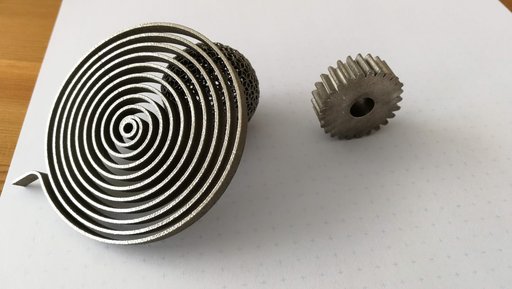The amorphous materials laboratory (amoLab) is focused on novel amorphous materials for innovative technologies, including Phase-Change Materials for future non-volatile phase-change memory devices and 3D-printed amorphous metals (bulk metallic glasses) for structural applications.
With synchrotron X-rays/neutron scattering and state-of-the-art thermal analytical techniques, we investigate the atomic-scale structure, thermodynamics, and kinetics of amorphous states of these materials. A better understanding of their properties and a deep insight into their atomic-scale structures are the driving force for technological innovations.

The novel material for the future non-volatile phase-change memory technologies.
Phase-change materials such as Ge-Sb-Te alloys can be reversibly rapidly switched between the amorphous (‘reset’) and crystalline (‘set’) states by electric or optical pulses in nanoseconds. The fast phase switching and the huge electrical and optical contrast between the two phases can be used for data storage applications.

A novel type of metals and alloys without crystalline structures.
The disordered structures make those metals extraordinarily strong with high hardness, large elastic limit, and the ability to be molded like thermo-plastics. They can be used for manufacturing biomedical implants and novel tools in harsh environment.
(* corresponding author)
Si-Xu Peng, Yudong Cheng, Julian Pries, Shuai Wei*, Hai-Bin Yu*, Matthias Wuttig*. Uncovering β-relaxations in amorphous phase-change materials.
Science Advances 6, eaay6726 (2020).
(Highlighted by RWTH University News)
Shuai Wei*, Pierre Lucas*, C. Austen Angell*. Phase-Change Materials: The view from the liquid phase and the metallicity parameter.
MRS Bulletin, 44, 694-698 (2019).
Julian Pries, Shuai Wei, Matthias Wuttig*, Pierre Lucas. Switching between Crystallization from the Glassy and the Undercooled Liquid Phase in Phase Change Material Ge2Sb2Te5.
Advanced Materials, 31, 1900784 (2019).
Peter Zalden*, Florian Quirin, Mathias Schumacher, Jan Siegel, Shuai Wei, Azize Koc, Matthieu Nicoul, Mariano Trigo, Pererik Andreasson, Henrik Enquist, Michael J Shu, Tommaso Pardini, Matthieu Chollet, Diling Zhu, Henrik Lemke, Ider Ronneberger, Jörgen Larsson, Aaron M Lindenberg, Henry E Fischer, Stefan Hau-Riege, David A Reis, Riccardo Mazzarello, Matthias Wuttig, Klaus Sokolowski-Tinten*. Femtosecond x-ray diffraction reveals a liquid–liquid phase transition in phase-change materials.
Science. 364, 1062–1067 (2019).
(highlighted by Science PERSPECTIVE “Catching structural transitions in liquids”
(news headlines on Physics World (IOP Publishing), Phys.org, etc.)
S. Wei*, Z. Evenson, M. Stolpe, P. Lucas, C. A. Angell*. Breakdown of the Stokes-Einstein Relation Above the Melting Temperature in a Liquid Phase-Change Material.
Science Advances, 4, eaat8632 (2018).
(news headlines on Physics World (IOP Publishing), Phys.org, ScienceDaily.com, etc.)
Shuai Wei, Garrett J. Coleman, Pierre Lucas, and C. Austen Angell*. Glass transitions, semiconductor-metal (SC-M) transitions and fragilities in Ge-V-Te (V=As, or Sb) liquid alloys: the difference one element can make.
Physical Review Applied, 7, 034035 (2017).
S. Wei*, M. Stolpe, O. Gross, W. Hembree, S. Hechler, J. Bednarcik, R. Busch, P. Lucas. Structural evolution on medium-range-order during the fragile-strong transition in Ge15Te85.
Acta Materialia. 129, 259-267 (2017).
Shuai Wei*, Fan Yang, Jozef Bednarcik, Ivan Kaban, Olga Shuleshova, Andreas Meyer & Ralf Busch. Liquid-liquid transition in a strong bulk metallic glass-forming liquid.
Nature Communications 4:2083 (2013).
(selected as DESY Highlights 2013, Press release on Phys.org, ScienceDaily.com)
Shuai Wei, Isabella Gallino, Ralf Busch & C. Austen Angell*. Glass transition with decreasing correlation length during cooling of Fe50Co50 superlattice and strong liquids.
Nature Physics 7, 178-182 (2011).
(press release on Phys.org)
For more, please see: A complete list of publications.

Tenure-track Assistant Professor in Materials Chemistry
VILLUM Young Investigator
AIAS Associated Fellow
Email: shuai.wei@chem.au.dk
Office: 1512, 314